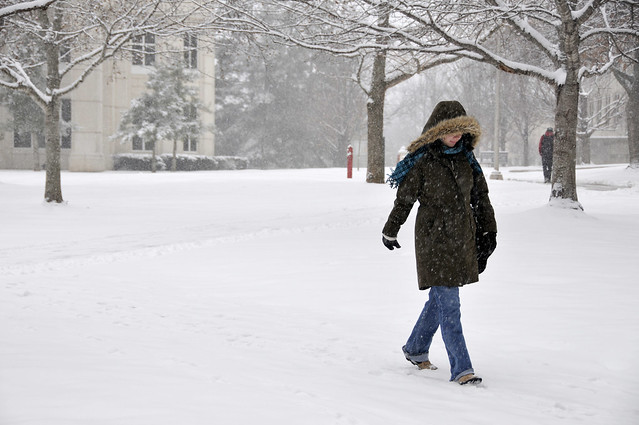Go easy on the salt: Winter walkways, safety and water quality
Jan. 11, 2018
By the U of A System Division of Agriculture
Fast facts
- Shoveling is first choice before ice forms
- Go easy on salt, de-icers to help water quality
(322 words)
Download Word version
FAYETTEVILLE, Ark. – When wintry precipitation creeps into the forecast, shovels should be the first choice for keeping walkways safe and slip-free, say water quality experts for the University of Arkansas System Division of Agriculture.
The National Weather Service offices in Tulsa, Oklahoma; North Little Rock and Memphis, Tennessee; were forecasting a mixed bag of wintry precipitation for Thursday evening through Friday. A winter weather advisory was in effect until noon Friday for Clay, Craighead, Crittenden Cross, Greene, Mississippi, Poinsett and St. Francis counties.

“Applying, salt, chemicals and sand to sidewalks, driveways and parking lots can harm the environment once the snow melts and becomes runoff into creeks through storm drains,” said Jane Maginot, Washington County extension agent for the Division of Agriculture, part of the “Know the Flow” stormwater team at the Washington County Extension Office.
“The first course of action would be to try and avoid putting anything down when possible,” she said.
“But because slipping is a health hazard, it is sometimes necessary for safety. If you do, use sparingly regardless of whether it’s sand or salt and sweep up any materials left after the slip hazard has gone away.”
The team has five suggestions for helping keep winter walking and driving safe as well as local streams and waterways:
- Shovel. Clear walkways before snow turns to ice. Apply salt only if needed.
- Select. Salt doesn’t melt ice below 15 degrees Fahrenheit. Use sand for traction when it’s too cold, or a different de-icer.
- Scatter. Use salt only where critical. Aim for 3 inches of space between salt granules.
- Sweep. Clean up any leftover salt, sand and de-icer to save and reuse as needed.
- Enjoy. Enjoy winter weather knowing you did your part to keep walkways and creeks safe.
For more information about water quality, contact your county extension office or visit www.uaex.uada.edu/stormwater. Look for tips on stormwater quality on social media with the hashtag #KnowTheFlowNWA.
About the Division of Agriculture
The University of Arkansas System Division of Agriculture’s mission is to strengthen agriculture, communities, and families by connecting trusted research to the adoption of best practices. Through the Agricultural Experiment Station and the Cooperative Extension Service, the Division of Agriculture conducts research and extension work within the nation’s historic land grant education system.
The Division of Agriculture is one of 20 entities within the University of Arkansas System. It has offices in all 75 counties in Arkansas and faculty on five system campuses.
Pursuant to 7 CFR § 15.3, the University of Arkansas System Division of Agriculture offers all its Extension and Research programs and services (including employment) without regard to race, color, sex, national origin, religion, age, disability, marital or veteran status, genetic information, sexual preference, pregnancy or any other legally protected status, and is an equal opportunity institution.
# # #
Media Contact: Mary Hightower
Dir. of Communication Services
U of A System Division of Agriculture
Cooperative Extension Service
(501) 671-2126
mhightower@uada.edu
Related Links